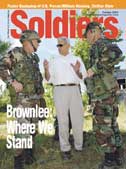Coalition helps build Afghanistan’s ‘West Point’
By Lt. Col. David Wallace
 The Military Academy Implementation Support Team conducts a candidate interview with Shoaib Yosoufzai, who was selected for the West Point Preparatory Scholarship Program.
The Military Academy Implementation Support Team conducts a candidate interview with Shoaib Yosoufzai, who was selected for the West Point Preparatory Scholarship Program.
|
|
|
KABUL, Afghanistan (Army News Service, Sept. 7, 2004) –– Teams of officers from the United States are working closely with their Afghan counterparts to establish the National Military Academy of Afghanistan, modeled after West Point.
The purpose of the NMAA is to provide the Afghan National Army with professional officers who support and defend the Constitution of Afghanistan, officials said.
The effort began in August 2003 when Maj. Gen. Karl Eikenberry, then chief of Office of Military Cooperation – Afghanistan, sought the assistance of the United States Military Academy in establishing a National Military Academy of Afghanistan. Lt. Gen. William J. Lennox Jr., USMA superintendent, sent Col. George B. Forsythe, USMA vice dean for education, and Lt. Col. Casey Neff, special assistant to the commandant for systems and planning, to assist with the efforts of establishing the military academy.
For a six-week period starting in October 2003, Forsythe, Neff and other international officers joined a working group from the Afghan Ministry of Defense to work in Kabul, to produce a concept plan that would serve as the blueprint for the new military academy. The plan outlined the NMAA’s mission and purpose, the three developmental pillars of the NMAA, a cadet leader development system, an honor code, and much more.
The concept plan envisions a rigorous four-year program which should prepare professional officers for service in the ANA and to the Afghan nation. Much like West Point, the NMAA will have three developmental pillars – academic, military and physical.
The academic program is designed to establish the intellectual foundation for service as a commissioned officer. Moreover, the plan explains how academic study develops in NMAA cadets, the knowledge and skills necessary for service and continued growth as an officer. During their first year at the NMAA, cadets will take courses in chemistry, information technology, composition, calculus, world history and introduction to the military profession.
Under the concept plan, the NMAA’s military program will provide an organized framework for the sequential and progressive military training and leadership development.
The ink hardly dried on the concept plan before a second team arrived from West Point to begin working on implementation. Lt. Col. Donna Brazil and Maj. Bill Caruso, both from the Behavioral Science and Leadership Department, made significant progress in making the NMAA a reality. Among other things, they developed a detailed implementation plan and identified a temporary site for the new academy. Additionally, they screened a pool of Afghan candidates for the USMA Class of 2008.
The current West Point team came together and hit the ground running.
Col. Barry Shoop, who is the chief of the current team, is a professor of electrical engineering and Electrical Engineering program director at West Point. The other member of the current team is Lt. Col. David Wallace, a faculty member in the Department of Law.
“The work we are doing here in Afghanistan is important to the future success of the army and the nation,” Shoop said. “A national military academy will teach a nascent Afghan National Army officer corps about their new constitution, civilian leadership of the military, what it means to be a member of the profession of arms, and to instill the values of duty, honor and country, and of selfless service to the nation.”
During the most recent term, much has been done to move the NMAA toward its opening in February 2005.
For example, the selection process for the NMAA’s key leaders moved forward. Within a relatively short amount of time, the Afghans will move forward with the board selection process and appointment of the NMAA’s key leadership.
Additionally, the Afghan minister of defense formally designated the former Air Academy in the vicinity of Kabul Airport as the temporary site of the NMAA. While this establishes the site for the NMAA, renovations to the facility are scheduled to begin soon.
The team developed and provided department head duty descriptions and credentials, faculty recruiting, a faculty development program and a computer network architecture. Finally, the team worked hard on the admissions process for the new military academy outlining key considerations for the first class and beyond. The first entering class for the new academy is projected to be 100 students. Most of the students will likely come from the Kabul Military High School.
In addition to the specific work on the NMAA, the current West Point team also screened and interviewed six Afghan candidates for admission to the United States Military Academy. One candidate, Shoaib Yosoufzai, has been selected for a West Point Preparatory Scholarship Program. He will study at a civilian university in the United States for a year to better prepare him for possible admission to the United States Military Academy next year.
Col. James Wilhite, U.S. Army Reserve, has been assigned to lead the NMAA implementation effort for OMC-A.
Wilhite, a lifelong educator and Soldier, is a professor at Northeastern State University in Tahlequah, Okla. He will provide continuity for the teams of West Point officers that will continue to come to Afghanistan to support the NMAA.
“History is when a significant event happens at any one time and place,” he said. “I believe we are on the verge of making such history in the establishment of the NMAA.”
(Editor’s note: Lt. Col. David Wallace serves with the Office of Military Cooperation – Afghanistan.)
|


